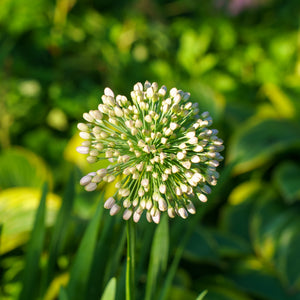The Allium Guide
Allium, commonly known as ornamental onions, is a genus of perennial, bulbous plants prized for their globe-like flower heads, striking vertical presence, and ability to attract pollinators. Known for their resilience and versatility, alliums add architectural interest to gardens with their vibrant purple, pink, white, and blue blooms. With species ranging from compact varieties like Allium 'Blue Eddy' to towering forms like Allium giganteum, these plants make excellent focal points, border accents, or naturalized drifts in garden landscapes. Here’s everything you need to know about growing and caring for Allium.
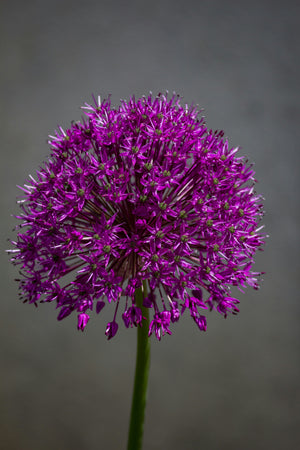
About
Alliums belong to the Amaryllidaceae family and include over 700 species, ranging from ornamental onions to culinary varieties like garlic (Allium sativum), chives (Allium schoenoprasum), and shallots (Allium cepa). These plants are recognized for their distinctive globe-shaped flower clusters, made up of numerous tiny florets, and their grassy, strappy foliage.
Ornamental alliums are cultivated for their striking, long-lasting blooms that appear in late spring to mid-summer. The flowers, often spherical or starburst-like, rise on tall, sturdy stems, creating an eye-catching display. Varieties such as Allium 'Purple Sensation', Allium 'Millenium', and Allium 'Gladiator' are known for their showy, pollinator-friendly blooms, while smaller types like Allium senescens 'Blue Eddy' offer a more compact alternative.
Alliums are easy to grow, deer-resistant, and drought-tolerant, making them an excellent choice for low-maintenance gardens. Their ability to naturalize over time ensures that they return year after year, providing reliable color and texture. Whether used as a focal point, mass planting, or border accent, alliums contribute to a dynamic and pollinator-friendly garden.
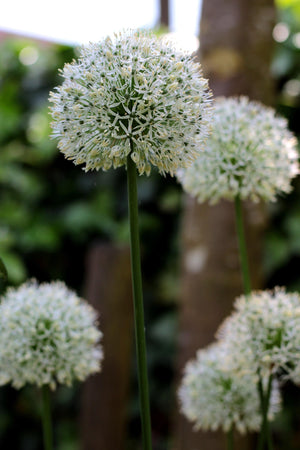
PLANTING
- USDA Hardiness Zones: Most ornamental alliums thrive in Zones 4-9, depending on the variety.
- Soil: Prefers well-draining, sandy, or loamy soil. Avoid overly wet or compacted soil to prevent bulb rot.
- Sunlight: Requires full sun (at least six hours of direct sunlight per day) for optimal flowering and growth.
- Watering: Water moderately during the growing season but allow the soil to dry between waterings. Overwatering can lead to bulb rot.
- Spacing: Space bulbs or plants 6-12 inches apart, depending on the variety, to allow for proper airflow and prevent overcrowding.
- Planting Time: Allium bulbs should be planted in the fall, typically from September to November, about 4-6 weeks before the ground freezes.
To plant allium bulbs, dig a hole 2-3 times the depth of the bulb, place the bulb pointy side up, and cover with soil. Water thoroughly after planting to help establish roots before winter dormancy. For container planting, use well-draining potting soil and place the container in a sunny location.
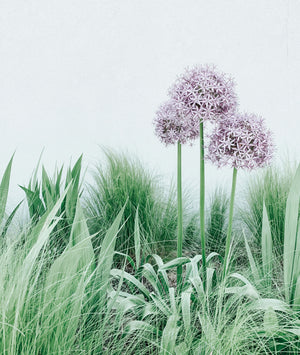
CARE
- Watering: Once established, alliums are drought-tolerant and require minimal watering. Water deeply during dry spells but avoid excess moisture.
- Fertilizing: Apply a balanced, slow-release fertilizer in early spring when new growth appears to encourage healthy blooms.
- Pruning: Remove spent flower heads after blooming to maintain a tidy appearance and prevent self-seeding in unwanted areas. Leave foliage intact until it yellows and withers, as this allows the plant to store energy for next season’s growth.
- Pests & Diseases: Generally pest-resistant, though they may occasionally attract aphids. Proper spacing and good air circulation help prevent fungal issues.
- Dividing: Many allium species multiply over time. Divide bulbs every 3-4 years in the fall if clumps become overcrowded or flower production declines.
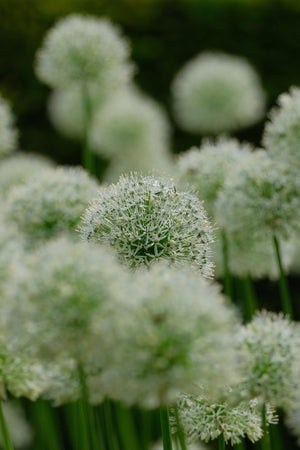
HOW TO USE
Alliums’ striking floral display and easy-care nature make them a valuable addition to various garden settings:
- Focal Point: Tall varieties like Allium 'Gladiator' and Allium 'Summer Beauty' create dramatic vertical interest in mixed borders and perennial beds.
- Pollinator Gardens: The nectar-rich blooms attract bees, butterflies, and other beneficial pollinators.
- Cut Flowers & Dried Arrangements: Alliums make excellent cut flowers, with their blooms lasting long in fresh bouquets and dried arrangements.
- Rock Gardens & Xeriscaping: Compact varieties like Allium 'Blue Eddy' and Allium 'Serendipity' thrive in dry, well-draining environments.
- Companion Planting: Pairs well with perennials like salvia, lavender, peonies, and ornamental grasses, providing contrast in shape and texture.
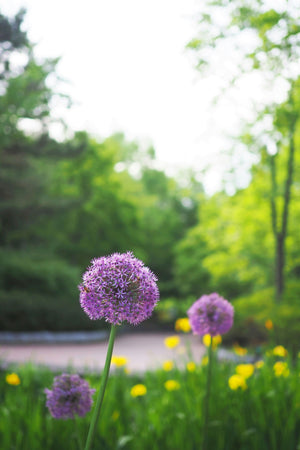
Common Questions
- What is Allium? Allium is a genus of perennial, bulbous plants known for their globe-shaped flowers and includes both ornamental and edible species.
- When to plant Allium bulbs? Allium bulbs should be planted in the fall, about 4-6 weeks before the ground freezes.
- Do Allium bulbs multiply? Yes, many alliums naturalize over time, forming clumps that can be divided every few years.
- How to plant Allium bulbs? Plant bulbs 2-3 times their depth in well-draining soil, with the pointed end facing upward.
- When do Alliums bloom? Most ornamental alliums bloom from late spring to early summer, though some varieties flower later in the season.
- Are Alliums perennials? Yes, ornamental alliums are hardy perennials that return each year.
- When to plant Alliums? Fall is the best time to plant Allium bulbs to ensure strong growth and flowering the following spring.
Conclusion
Alliums are a striking addition to any garden, providing bold color, architectural form, and pollinator benefits with minimal upkeep. Whether used as a focal point, in mass plantings, or as a pollinator-friendly addition, these ornamental onions bring elegance and structure to landscapes. With varieties like Allium 'Purple Sensation', Allium 'Millenium', and Allium 'Graceful Beauty', there’s an Allium for every garden setting. Explore our selection and enjoy the beauty and resilience of alliums in your outdoor space.
The Allium Collection
Sold Out
Sold Out


